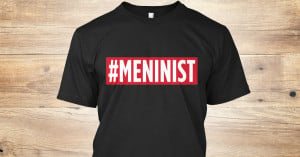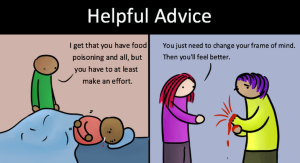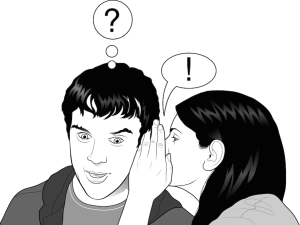
Source: CNN
Teen and “tween” (that difficult, in-between age of 9-12) girls nowadays have it rough.
Higher academic standards, more pressure than ever to fit in, the stress to look perfect, and act perfect, all while simultaneously acting like they’re not trying to be perfect, that they simply are that perfect.
Whew! Talk about pressure.
Contrast this with the caveman era that I grew up in, that oh-so-long-ago decade known as the 1990s, in which girls could simply chillax and be themselves…kind of.
And it’s not that those of us growing up in any bygone eras were free from societal (let alone peer) pressure, but rather the pressure of the past looked different.
Maybe I’m wearing hindsight rose-colored glasses, but it at least feels like girls of the past had more opportunity to develop authentic selves – or at least weren’t bombarded from every angle with the seductive marketing that consumerism and conformity to sexist ideals is your authentic self.
And with the advent of social media (where we can look at ourselves and our peers instantly, rather than having to wait for the film to develop), the pressure that girls today feel is constant.
And I think that before we roll our eyes at the behavior of “kids these days,” we should at least consider how our adolescence was different.
Even just in the ‘90s.
So without further ado, here are the reasons why it’s harder to be a teen now than it was then:
#1. Now: Tight Clothing, Then: Grunge Clothing
When I was a teen, the grunge trend was all the rage, and we girls had a brief respite from the body-constricting clothing en vogue in the ‘80s (think Flashdance) and again at the turn of the century.
Kurt Cobain told us to come as we are, and we did — in our Silver Tab jeans, No Fear shirts, and our dads’ flannels.
But now? In the words of your grandmother (probably): Have you seen what girls are wearing these days?
And unfortunately, it’s hard to address this scary trend.
It’s not as simple as saying, “Girls, stop dressing like slores” (slutty whores, in modern-day Girlspeak). Because that would mean being ostracized and condemned by one’s peers for not being trendy, and really, who would want that?
It’s just more pressure to add to their already full plates.
But we really need to spend more time addressing why these pressures exist and why the sexualization of women as an ideal is becoming attractive to younger and younger girls.
#2: Now: Sexual ‘Empowerment,’ Then: Feminist Revival
In today’s world, the media has teen girls (and women in general) believing that the equality battle has been won, that we don’t need feminism because we have the right to vote, play sports, work at any job, and are even graduating from college more than men are.
And while all this is amazing, there is still work to be done. Women are being beaten, raped, and undermined in “casual” ways every day.
But instead of addressing these bigger issues, the media shows girls that it’s preferable to use their sexuality as a form of “empowerment.”
Yes, there are female role models like Beyoncé, Rhianna, and Katy Perry who have dominated the world of pop culture, but how did they get there? Of course by being talented, but also by being sexy.
And there isn’t anything inherently wrong with wanting to be sexually attractive or with being outright and honest about your sexuality.
But there is something wrong with a society that teaches young women that they are defined by their sexuality, that that’s all they’re worth.
By contrast, in the ’90s, we experienced a bit of a feminist revival in the media.
Groups like The Indigo Girls and Bikini Kill exploded onto the scene and taught us Grrrrl Power – one that was much more genuine and stick-it-to-the-man than the Spice Girls’ version.
I’ll tell ya what I want, what I really, really want, and it’s not to be sexually exploited.
#3: Now: Size 6 is the New 14, Then: Size 6 Was Thin
I’m sure some of you have heard these stats before, but I’m going to enlighten you anyway.
In 1992, the average model was a size 4 or 6. Today, she is a size 0 or 2.
The unattainable standard of beauty has become unattainable-er.
And while clearly, most girls will never be models, they still look up to these women as the Ideal Standard by which to live, as evidenced by the rising rates of eating disorders and disordered eating and the thinspiration boards on Pinterest.
So much for the Jessica and Elizabeth Wakefield of Sweet Valley High and their “perfect size six.”
In today’s world, that’s practically considered plus-size.
Even ex-supermodel Tyra Banks admitted that if she were just starting out today in modeling, she would not have made it.
Beauty, of course, comes in all shapes and sizes.
But manipulating young minds into believing that beauty is only legitimate if it can fit into a pair of size zero jeans is problematic.
When are we going to stop this trend of female attractiveness being defined as smaller and smaller, as taking up as little space as possible?
We are very well on our way to disappearing.
#4: Now: Cyberbullying, Then: Bullying
On a Friday night in 1991, my friend Keely convinced my friend Katie to call me and talk smack while Keely listened in on the other line in the hopes that I would say horrible, evil things about her and reveal my true tween nature.
Well, it worked.
I hung up the phone and cried to my mom about how deceitful she was, convinced that my life was over.
And was that bad?
Yeah.
But the difference between bullying now and bullying then, however, is that now we have that wonderful love-it-but-hate-it invention called the Internet. And cell phones equipped with text messaging. And Twitter, Facebook, and on and on.
In 1991, I cried and had my pity party, but then a few hours later, I recovered and went to watch Clarissa Explains It All, freed from the oppressive tyranny for at least the weekend.
Teens nowadays don’t have that freedom.
They can criticize each other ‘round the clock, all the while cowardly hiding behind the glows of their laptop or iPhone screens, until something they’ve said causes lasting damage, or worse.
As an adult, it’s easy to dismiss bullying as “hijinks” or “a phase.”
What’s difficult to understand is that unlike us, these kids get no break from the relentless torture. No evenings or weekends free from the harassment. Just by logging into their Twitter account on a random Monday night, they might see a message that says, “Hey, fat, stupid slut. How’s it goin’?”
And it eats away at them. Every day. Little by little.
At age 12 or 15 or even 18, some don’t have the foresight to see that they will have a future that won’t be dominated by constant bullying. And that’s enough to drive someone over the edge.
#5: Now: Perfection Required, Then: Do Your Best
Girls today feel the need to be perfect in every way – physically, academically, morally, you name it.
When I was in high school, it was enough to do your best. Get into a decent school, but don’t worry if you don’t get into a top school. Just be yourself; boys will like you no matter what.
When I was a teen, of course we still dated, but oftentimes, it was on the way out of adolescence.
You ask a teens today if they’ve ever been on a date, and they look at you like, “Okay, 1950s woman,” followed by an eye roll.
Teens today participate in Hook-Up Culture, where they make out or have sex hoping that their partners will consider them worthy enough to be in a relationship with, which can be messy stuff.
And that’s not to say that young women can’t wield their sexual prowess at will, but it’s important to note the pressure for them to “grow up too fast” – to become adults (or adult-like) before they even have the cognitive function to think through their choices.
***
With all of these demands on the average teen girl, it’s hard to know where to begin.
If you’re a parent, friend, aunt, cousin, or mentor of a tween or teen girl, I encourage you to seek out resources to help your teen better navigate this turbulent time in their lives.
Here are some below:
What are some ways in which t(w)een girl culture today differs from your own experience of adolescence? And in what ways can we combat it?
Want to discuss this further? Login to our online forum and start a post! If you’re not already registered as a forum user, please register first here.
Shannon Ridgway is a Contributing Writer to Everyday Feminism from the great flyover state of South Dakota (the one with the monument of presidential heads). In her free time, Shannon enjoys reading, writing, jamming out to ’80s music and Zumba, and she will go to great lengths to find the perfect enchilada. Follow her on Twitter@sridgway1980. Read her articles here.
Search our 3000+ articles!
Read our articles about:
Our online racial justice training
Used by hundreds of universities, non-profits, and businesses.
Click to learn more



















